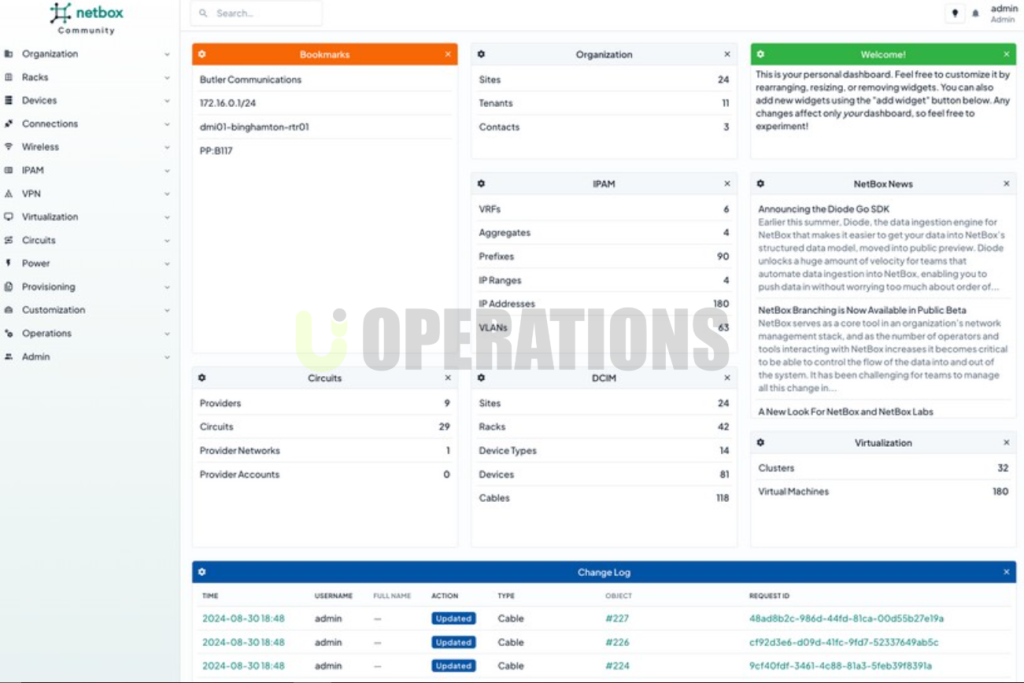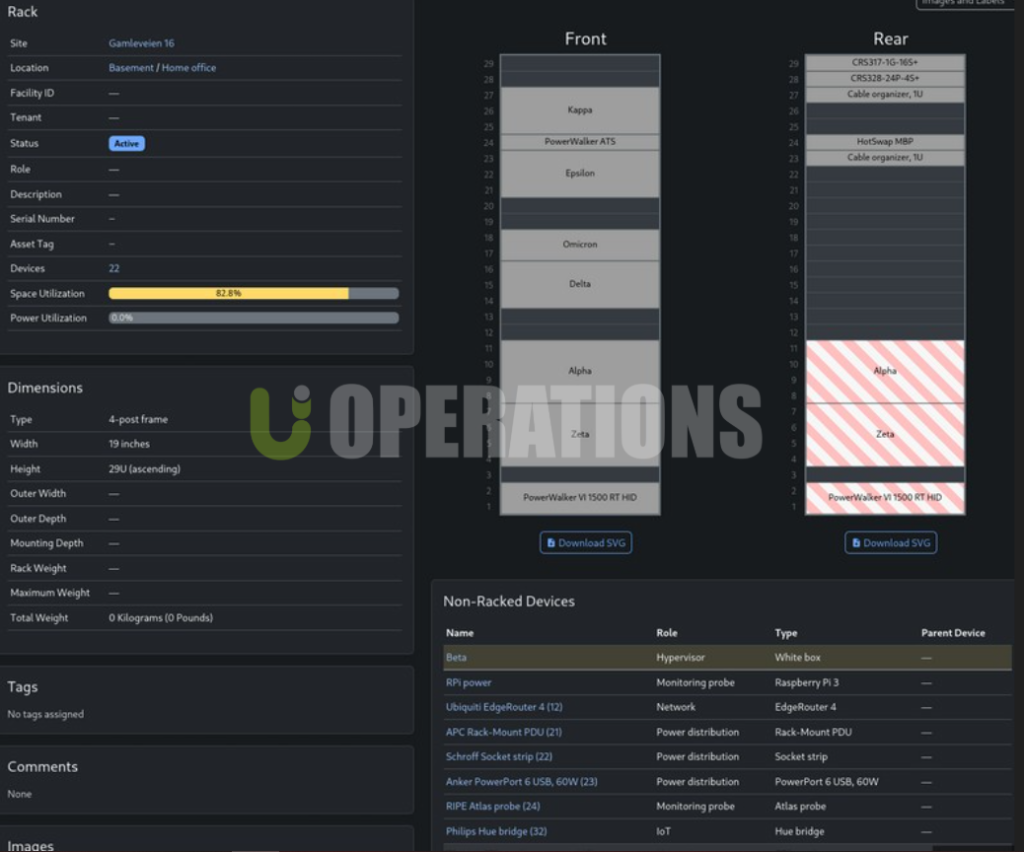Portfolio Details
NetBox Integration and Deployment
Price: 1000$
Duration: 1 Week
01
Client Requirement
The client approached us to integrate NetBox, an open-source IP address management (IPAM) and data center infrastructure management (DCIM) tool, into their network management operations. Their primary requirements were:
- IP Address Management (IPAM):
The client needed an efficient way to track, allocate, and manage IP addresses within their network. This included tracking IP address usage, subnet allocation, and ensuring that all IP addresses were fully utilized. - Data Center Infrastructure Management (DCIM):
The client required a comprehensive solution for managing their data center infrastructure. This involved tracking devices, racks, power configurations, and maintaining an inventory of physical assets. - Automation and Integration with Other Tools:
The solution had to integrate seamlessly with existing network monitoring and configuration management tools. This integration aimed to streamline operations, enhance data accuracy, and eliminate manual errors. - Centralized Management Interface:
The client wanted a centralized web interface that allowed for easy access to the network, infrastructure, and IP address data. This interface needed to be user-friendly and scalable for future growth. - Security and Access Control:
As the solution would manage sensitive network data, the client required strong security protocols and role-based access control (RBAC) to ensure that users could access only the data they were authorized to view or modify.
- IP Address Management (IPAM):
02
Solution Delivered
To address the client’s requirements, we deployed and integrated NetBox into their network environment. The integration followed a structured approach to ensure that NetBox met the client’s needs for IPAM and DCIM functionalities while providing the scalability and security needed for future growth.
- NetBox Deployment and Configuration:
We began by deploying NetBox on a dedicated server using Docker for containerized deployment, allowing easy scalability and easier management. We used the following configuration:
- NetBox Installation: Deployed on Ubuntu servers, using Docker to create a containerized environment for better management and isolation.
- Database Setup: The backend database for NetBox was configured using PostgreSQL, ensuring data integrity, performance, and ease of management.
- Web Server Configuration: We configured Nginx as a reverse proxy to handle incoming web traffic and ensure high availability.
- NetBox Deployment and Configuration:

- IP Address Management (IPAM) Setup:
One of the core features for the client was IP address management. We implemented the following:
- IP Address Allocation: Configured IP address blocks (IPv4 and IPv6), subnets, and pools within NetBox, following the client’s network design.
- IP Usage Monitoring: Set up automated monitoring to keep track of IP addressutilization and send alerts when thresholds are reached, ensuring efficient IP address allocation.
- Subnet Hierarchies: Created subnet hierarchies to better organize IP space, track address allocation, and manage subnet assignments based on physical locations or departments.
- Automated IP Address Assignment: Integrated with Ansible for automated IP address assignment across the network, ensuring that new devices receive proper IP addresses based on predefined policies.
- Data Center Infrastructure Management (DCIM) Setup:
In parallel to IPAM, we focused on managing the client’s data center infrastructure using NetBox:
- Data Center Infrastructure Management (DCIM) Setup:
- Device Inventory Management: Created a comprehensive inventory of network devices, servers, routers, switches, and other physical assets within the data center.
- Rack and Data Center Mapping: Configured rack layouts within NetBox, mapped the location of each device, and managed physical connections between devices (ports, interfaces, cables).
- Power and Connectivity: Set up power connections and network interfaces to monitor and control device configurations. We also ensured that the rack space and physical devices were easily identifiable and traceable.
- IP Address Management (IPAM) Setup:

- Automation and Integration:
To integrate NetBoxwith the client’s other systems, we employed API integration and automation tools:
- API Integration: NetBox’s powerful REST API was leveraged to integrate with the client’s existing network monitoring systems, configuration management tools, and ticketing systems (such as ServiceNow or Jira) to keep device and IP address data synchronized in real-time.
- Automated Provisioning: Integrated with Ansible to automate the deployment of network devices and automatically update NetBox’s database when new devices or IP addresses were added to the network.
- DNS Integration: We integrated DNS management by syncing NetBox with existing DNS servers to automatically update IP-to-hostname mappings in both IPAM and DNS.
- Security and Access Control:
Security was a critical aspect of the deployment, so we implemented:
- Security and Access Control:
- Role-Based Access Control (RBAC): Configured RBAC within NetBox, ensuring that users only had access to data and functionality relevant to their roles. For example, network engineers were given full access to device configurations, while operations teams were restricted to monitoring data center layouts.
- SSL Encryption: Implemented SSL encryption for secure access to the NetBox interface, ensuring that all communications between the client and the system were encrypted and protected from man-in-the-middle attacks.
- Authentication Integration: Integrated Single Sign-On (SSO) with existing Active Directory or LDAP systems for centralized user authentication.
- User Interface Customization:
We customized the NetBox web interface to ensure it met the client’s requirements for usability:
- User Interface Customization:
- Dashboard Customization: Customized the dashboard to display essential information such as IP utilization, device status, available rack space, and network health in real-time.
- Reports and Analytics: Enabled features for generating custom reports on IP address usage, network topology, and device inventory, providing management with better visibility into the infrastructure.
- Search and Filter Capabilities: Enhanced search capabilities to allow users to easily find devices, subnets, or IP address ranges based on various attributes such as location, rack, or status.
- Automation and Integration:
03
Key Achievements
- Improved IP Address Management:
With automated IP address allocation, the client now had clear visibility into IP address utilization and could better manage their IP space to avoid conflicts and wastage. - Centralized Data Center Management:
NetBox enabled centralized management of the client’s entire data center infrastructure, including device inventory, network topology, and physical racks. This improved operational efficiency and allowed quick identification of any issues related to physical assets. - Increased Operational Efficiency through Automation:
Through integration with Ansible and automated provisioning processes, the client was able to automate tasks such as IP address assignment and device configuration, reducing the risk of human error and speeding up deployment times. - Enhanced Security with RBAC:
The implementation of role-based access control ensured that users had access only to relevant parts of the system, improving data security and ensuring that sensitive information was only available to authorized personnel. - Seamless Integration with Existing Tools:
The integration with the client’s existing monitoring tools, DNS infrastructure, and ticketing systems allowed for streamlined operations and better coordination between teams, while keeping all systems synchronized.
04
Challenges Overcome
- Legacy System Integration:
The integration of NetBox with existing legacy systems required careful mapping and synchronization to ensure that data between platforms remained consistent. We successfully configured the API integrations to keep all information up-to-date across the client’s entire IT environment. - Scalability for Future Growth:
We ensured that the deployment was scalable, with the system capable of supporting an increasing number of devices, IP addresses, and subnets as the client’s network expanded. - Complex Network Topology Management:
Managing complex network topologies, especially in large data centers, required creating an intuitive and easy-to-navigate structure within NetBox, which we achieved by setting up clear rack layouts and linking devices to their physical connections.
05
Technologies & Tools Used
- NetBox: IP Address Management (IPAM), Data Center Infrastructure Management (DCIM), Rack Management, API Integration
- Docker: Containerized NetBox deployment
- PostgreSQL: Database for storing IP and infrastructure data
- Ansible: Network automation for device provisioning and IP address management
- Nginx: Reverse proxy for high availability and secure access
- SSL Encryption: Secure web access
- LDAP/Active Directory: Authentication integration for user management
06
Outcomes
The client successfully implemented NetBox for both IP address management (IPAM) and data center infrastructure management (DCIM), resulting in:
- A streamlined and efficient management of IP address allocations and data center assets.
- Automated workflows, reducing manual intervention and improving operational efficiency.
- Enhanced visibility and reporting across the network infrastructure.
- Improved security through role-based access control (RBAC) and secure access protocols.
07
Conclusion
This NetBox integration and deployment project provided the client with a scalable, secure, and highly efficient solution for managing their network infrastructure and IP address resources. The implementation empowered the client with automation, better visibility, and a robust system for managing the growth of their infrastructure.


